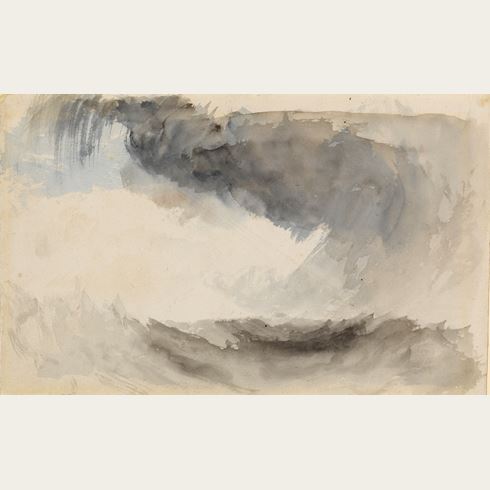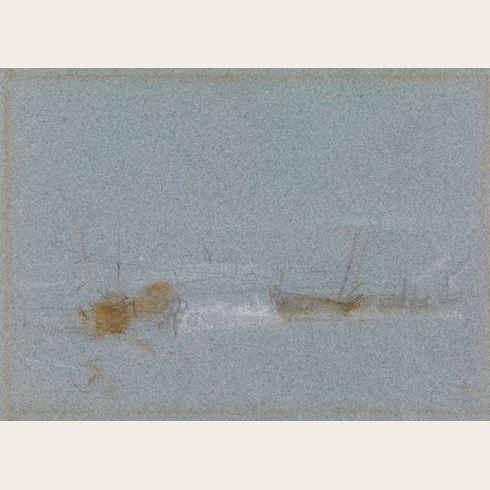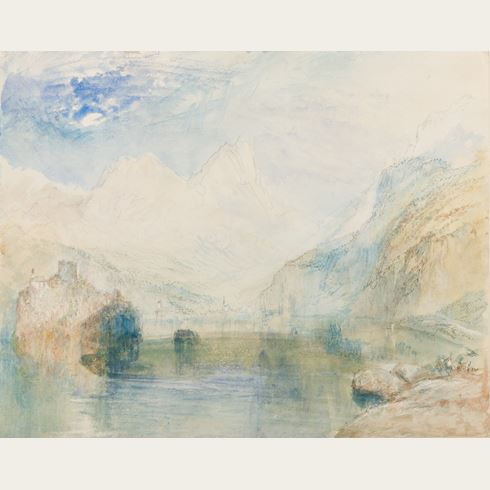Joseph Mallord William TURNER
(London 1775 - London 1851)
The Grand Bridge at Blenheim Palace, Oxfordshire
301 x 464 mm. (11 7/8 x 18 1/4 in.)
Arguably the most significant of these projects was a series of one hundred watercolours - ninety-six of which were published by the engraver Charles Heath as Picturesque Views in England and Wales - on which Turner worked between 1824 and 1838. The finished watercolours for the Picturesque Views in England and Wales series represent perhaps the finest topographical works of the artist’s career. As the Turner scholar Andrew Wilton has noted of the group, which was originally intended to number one hundred and twenty watercolours, ‘there is almost nothing in English art to compare with them for universality and compassion. To the extent that the England and Wales series, taken as a whole, exhibits Turner’s humanity at its broadest and subtlest, it is the central document of his art, and the most complete expression of a profound theme in the history of landscape.’ As might be expected, Turner produced a significant number of working studies and sketches, in both pencil and watercolour, for each of the finished Picturesque Views in England and Wales compositions.
While on a tour of the Midlands between August and October of 1830, to collect new material for the Picturesque Views in England and Wales, Turner visited Blenheim Palace in Oxfordshire, the seat of the Dukes of Marlborough. In his ‘Kenilworth Sketchbook’, now part of the Turner Bequest at Tate Britain3, he recorded in pencil studies the architecture of the Palace, built to the designs of Sir John Vanbrugh between 1705 and 1722, as well as the surrounding park and gardens later designed by Lancelot ‘Capability’ Brown. As Eric Shanes has described Turner’s usual practice, ‘The artist rarely painted out-of-doors, for in the time it took him to create one watercolour in the open-air he could make several in his studio. Usually he would select a line drawing of a subject that he might have made in one of his sketchbooks many years before, a sketch or study that almost invariably contained no indications of lighting, weather or staffage, thus leaving his imagination to invent such details or supply them from memory.’ Turner was particularly struck by the 18th century Grand Bridge at Blenheim, built by Vanbrugh in 1708, which was more than 120 metres in length and some fifteen metres tall, with a central arch thirty metres wide5.
This large watercolour by Turner depicts Blenheim Palace and its grounds with the Grand Bridge, seen from the Woodstock Gate, the main entrance to the park. Two other so-called ‘colour beginnings’ of Blenheim, both in the Turner Bequest at the Tate, also depict the house and its grounds. One of these is quite close in composition to both the finished watercolour and the present sheet, while the other sketch shows the park at Blenheim from a different viewpoint, looking southeast, across the lake. Both works share with the present sheet a great sense of freedom and a summery palette.
Upon his return to London, Turner began to consider possible compositions for a large watercolour of Blenheim and its surroundings. This eventually resulted in the finished watercolour of Blenheim Palace and Park, Oxfordshire, painted in the late autumn and winter of 1830-1831 and today in the collection of the Birmingham Museum and Art Gallery. The large, completed watercolour of Blenheim Palace and Park was exhibited, along with nearly eighty other watercolours for the Picturesque Views in England and Wales, in London in June and July of 1833. The same view was engraved by William Radclyffe as part of the project, and was published in 1833.
The present sheet may be grouped with a large number of rapidly drawn watercolours by Turner that have been defined, by Alexander Finberg in his 1909 inventory of the Turner Bequest at the Tate, as ‘Colour Beginnings’. Finberg was referring to a miscellaneous group of 386 watercolours in the Turner Bequest - including numerous colour sketches, as well as preparatory studies, test sheets, and finished and unfinished watercolours - spanning a period of more than thirty years of the artist’s career. Two such ‘colour beginnings’, both today in the Whitworth Art Gallery at the University of Manchester, are very close to the present sheet in style and handling, as well as size, and must be of the same date. Ian Warrell has further suggested that a watercolour of Dumbarton Rock, West Scotland, recently sold at auction in London, may be part of the same group.
A recent owner of the present sheet was the Conservative politician Philip Cunliffe-Lister, 1st Earl of Swinton (1884-1972), a prominent figure in British politics and a government minister from the 1920s to the 1950s.
Provenance
Possibly Percy Moore Turner, London and Paris
Sir William Arthur Colgate, London and Bembridge, Isle of Wight
Spink & Son Ltd., London (as The Dark Bridge)
Philip Cunliffe-Lister, 1st Earl of Swinton, London and Swinton Park, North Yorkshire
Thence by descent.
Literature









